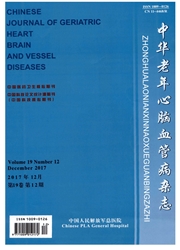

 中文摘要:
中文摘要:
目的观察大动脉粥样硬化性脑梗死(LAA)患者阿司匹林疗效及预后,探讨阿司匹林抵抗(AR)与LAA复发的相关性。方法采用前瞻性队列研究方法,选择南京卒中注册系统中首发LAA患者206例,分为AR组31例和阿司匹林敏感(As)组175例。并且根据随访结果,又分为LAA无复发患者177例和LAA复发患者29例。所有患者均服用阿司匹林100mg/d〉7d,使用血栓弹力图检测AR情况,并对患者随访6-12个月。分析LAA患者AR的相关危险因素,并观察LAA复发及血管事件发生情况。结果随访中,共失访11例(5.3%);死亡9例(4.4%)。AR组LAA复发率明显高于AS组(54.8% vs 6.9%,P〈0.01)。与LAA无复发患者比较,LAA复发患者年龄较大,糖尿病、AR、抗血小板药物依从性差比例明显升高,差异有统计学意义(P〈0.05,P〈0.01)。logistic回归分析显示,AR与LAA复发显著相关(OR=4.716,95%CI:1.499-14.835,P=0.008)。结论AR能显著增加LAA患者复发的风险。
 英文摘要:
英文摘要:
Objective To study the relation between aspirin resistance (AR) and recurrent ischemic stroke by observing the therapeutic effect of aspirin and prognosis in patients with large artery atherosclerosis (LAA). Methods Two hundred and six first-ever LAA patients, selected from Nanjing Ischemic Stroke Registry System,were divided into AR group (n=31) and aspirin-sensi- tive (AS) group (n= 175),and further divided into non-recurrent LAA group (n= 177) and recur- rent LAA group (n=29) according to their follow-up findings. The patients were treated with as- pirin, 100 mg a day for 7 days. Their AR was detected by thrombolastography. The patients were followed up for 6--12 months. The risk factors for AR in LAA patients were analyzed. Recurrent LAA and vascular events were observed. Results Eleven patients (5. 3%) lost their follow-up and 9 patients (4.4%) died during the follow-up period. The recurrent rate of LAA was signifi- cantly higher in AR group than in AS group (54.8%vs 6.9%,P〈0.01). The age of recurrent LAA patients was older than that of non-recurrent LAA patients(P〈0.05). The drug depend- ence of diabetes mellitus and AR was significantly higher in recurrent LAA patients than in non- recurrent LAA patients (P〈0.01). Logistic regression analysis showed that AR was significantly related with recurrent LAA (OR=4. 716,95% CI:1. 499-14. 835,P=0. 008). Conclusion AR can significantly increase the risk of recurrent LAA.
 同期刊论文项目
同期刊论文项目
 同项目期刊论文
同项目期刊论文
 Angiotensin-Converting Enzyme Insertion/Deletion Polymorphism Contributes to Ischemic Stroke Risk: A
Angiotensin-Converting Enzyme Insertion/Deletion Polymorphism Contributes to Ischemic Stroke Risk: A Asymptomatic cerebral microbleeds in adult patients with moyamoya disease: a prospective cohort stud
Asymptomatic cerebral microbleeds in adult patients with moyamoya disease: a prospective cohort stud Correlation between ABCD, ABCD2 Scores and Craniocervical Artery Stenosis in Patients with Transient
Correlation between ABCD, ABCD2 Scores and Craniocervical Artery Stenosis in Patients with Transient Microbleeds in ischemic stroke are associated with lower serum adiponectin and higher soluble E-sele
Microbleeds in ischemic stroke are associated with lower serum adiponectin and higher soluble E-sele Asymmetrical cortical vessel sign onsusceptibility-weighted imaging: a novel imaging marker for earl
Asymmetrical cortical vessel sign onsusceptibility-weighted imaging: a novel imaging marker for earl Does large vessel occlusion affect clinical outcome in stroke with mild neurologic deficits after in
Does large vessel occlusion affect clinical outcome in stroke with mild neurologic deficits after in Correlation of matrix metalloproteinase-2 single nucleotide polymorphisms with the risk of small ves
Correlation of matrix metalloproteinase-2 single nucleotide polymorphisms with the risk of small ves 期刊信息
期刊信息
